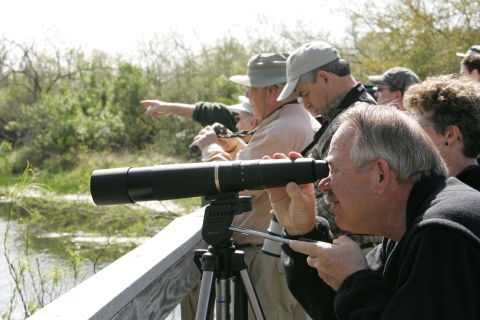Facility Activities
Santee NWR is open daily from dawn until dusk with vehicular access on the Cuddo Unit limited to the following times:
October 1 – February 28: 7 am – 5 pm
March 1 – September 30: 6 am – 8 pm
An automatic gate on the Cuddo Unit controls hours of vehicular access to minimize disturbance to wildlife. Please note the Cuddo unit is closed on Mondays.
Wildlife observation is one of the primary public uses of National Wildlife Refuges. Getting out and learning to identify wildlife species in their native habitat can be very exciting and rewarding. The refuge has 2 observation towers (Bluff Unit and Dingle Pond Unit) as well as several other areas that are great for spotting wildlife. It is recommended that visitors bring a pair of binoculars and a field guide when visiting the refuge, but in case you forget, stop by the visitor center, and take advantage of the loaner program the refuge has available.
The four units on the refuge each offer a variety of outdoor recreation activities for the refuge visitor. The Visitor Center and the Santee Indian Mound-Fort Watson site are found at the Bluff Unit. Hiking the Wright’s Bluff Nature Trail gives visitors a chance to observe a variety of wildflowers, songbirds, small mammals and reptiles. The north side of this trail, along Cantey Bay, is a great place to observe wading birds, Canada Geese, shorebirds and other wetland species. An observation platform and a 15-foot observation tower provide opportunities to view wildlife.
Home to a 350 acre Carolina Bay, Dingle Pond is a unique “depressional” wetland typically fed by rain and natural springs. This area is home to a variety of wildlife species some of which are unique to Carolina Bays. A one-mile dirt trail is open for hiking and provides access to an observation tower overlooking the bay.
The Pine Island and Cuddo Units provide the greatest diversity of habitats of the four units. Visitor access to Pine Island is limited to foot and bicycle traffic on approximately 4 miles of roads. A primitive boat launch area is provided for small boats, canoes and kayaks. A 7.5 mile wildlife drive and 5 miles of hiking trails on the Cuddo Unit give visitors great opportunities for wildlife observation. Turkey, white-tailed deer and very large alligators are common. An additional 8.5 miles of hiking/bicycling trails let visitors explore fields, woods and wetlands, and there are over 8 miles of canoe and kayak trails. An automatic gate on the wildlife drive controls the hours of access to minimize disturbance to wildlife.
Some hiking/biking trails are closed during November 1 – March 1 for the waterfowl sanctuary period. All trails are closed during the deer hunting season. Please call the Headquarters at 803.478.2217 for closures.
Birding is a popular activity, especially during the Spring and Fall migrations. Excellent birding opportunities exist on all four units of the refuge. A walk along the one-mile Wrights Bluff Nature Trail and one-mile trail at Dingle Pond affords visitors the chance to observe a great diversity of songbirds, wading birds, and several species of waterfowl.
Visitor access on portions of the refuge is seasonally limited to provide migratory bird sanctuary areas for wintering ducks and geese. The waters of Cantey Bay, Savannah Branch and Black Bottom are closed to all access from November 1 to March 1 along with the land areas north of the Wrights Bluff Nature Trail and west of the Wildlife Drive in the Cuddo Unit. Visitors should check with the refuge office for details.
Located on the banks of the largest lake in South Carolina (Lake Marion), Santee National Wildlife Refuge has great fishing opportunities.Whether you are bank fishing or fishing from a boat, there are opportunities to catch a wide variety of freshwater fish species. Lake Marion is well-known in the fishing community for having several state record-sized fish caught in the lake - come out and try your luck!
Seasonal opportunities for hunting White-tailed deer are available at the Bluff, Cuddo, and Pine Island Units of the refuge. Hunters from all over the state come out to the woods of Santee in the hopes of harvesting a deer or feral hog. No alligator hunting or waterfowl hunting permitted within refuge boundaries. Be sure of your location and the refuge boundary when hunting on the waters of Lake Marion.
Both hunting and fishing are permitted, subject to state, federal and refuge regulations. Fishing and hunting regulations and permits are available at the refuge office and from our website at no cost to visitors. The permit must be signed and in you possession while conducting these activities on the refuge.
Plan to bring insect repellent during warm months and wear layered clothing during cool weather.




